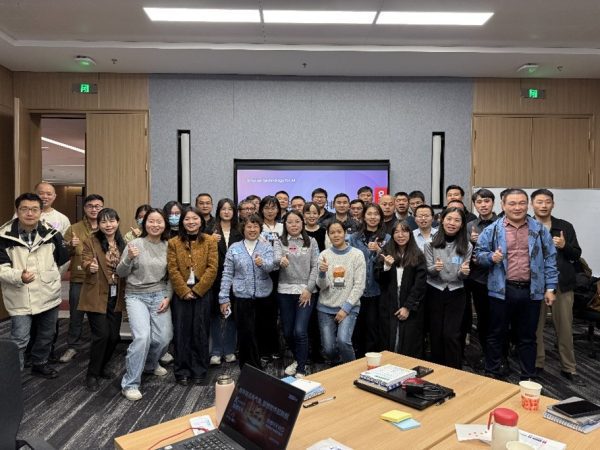As a global technology powerhouse, Lenovo is driven by a strong and resilient global supply chain – ranked in the Gartner Supply Chain Top 25 for three consecutive years. But at our scale of manufacturing and production, our supply chain operations make up half of our carbon footprint. That’s why engaging our suppliers, partners and value chain stakeholders is critical to reaching net-zero emissions by 2050.
This commitment to shared progress isn’t new. Through initiatives like the Lenovo 360 Circle, we’ve been working closely with our channel partners to align on sustainability goals and accelerate action. We’re extending that same collaborative spirit into our global supply chain, recognizing the essential role suppliers play in reducing emissions and driving meaningful impact at scale.
Our Global Supply Chain (GSC) team is helping lead this transformation. From renewable energy pilots to energy-saving workshops, we’re working hand in hand with our suppliers to reduce emissions, share knowledge, and co-create a more sustainable supply chain.
A growing network of committed suppliers
Lenovo’s Supplier Emissions Reduction Program was launched in 2022 and now suppliers represents 98% of our total procurement spend. The aim of this program is simple but ambitious: to help suppliers reduce their emissions in alignment with Lenovo’s Net-Zero roadmap.
Through the program, we ask suppliers to disclose their emissions through CDP, develop emissions inventories, and define climate targets—ideally those aligned to the Science-Based Targets initiative (SBTi), and take actions to reduce emissions. While suppliers are at different stages of their climate journeys, we work with them through a tiered approach, prioritizing support and collaboration based on suppliers’ emissions management maturity levels, impact, and readiness to drive meaningful climate action across the supply chain.
In 2023, our CDP supplier response rate was 97%, ranking among the top 5% in the world. Around 70% of our participating suppliers report Scope 3 data. To support the remaining 30%, we’ve introduced CDP training sessions, one to one meetings, and plan to offer additional resources going forward. In addition, in FY23/24, 95% of suppliers by spend have public greenhouse gas reduction goals, 76% of suppliers by spend have public renewable energy goals, and 94% of suppliers by spend are tracking and reporting renewable energy generation and purchases. In the longer term, we’ll encourage our suppliers to report Product Carbon Footprint (PCF) data, increase their use of renewable energy, and implement innovative projects for decarbonization.
A renewable energy pilot in Guangdong
One example of this collaborative approach is our renewable energy group purchase pilot in Guangdong, China—home to many of Lenovo’s supplier factories and our own Lenovo South Smart Campus (LSSC) factory in Shenzhen.
Through this pilot run in 2024, four suppliers already engaged in our Supplier Emissions Reduction Program joined Lenovo in a group purchase of renewable electricity. The goal: to make clean energy more accessible and competitive by combining demand and building collective momentum for change.
Together, Lenovo and participating suppliers are expected to reduce an estimated 30,000 metric tons of emissions in 2025—a significant step forward on our joint emissions reduction journey.
This pilot underscores the power of partnership, showing how coordinated action can create value for suppliers, drive emissions reductions, and strengthen resilience across the supply chain.
Building energy-saving momentum through supplier workshops
In January 2025, we hosted our first onsite energy-saving workshop at Lenovo’s LSSC campus. Over two days, 40 representatives from 25 supplier companies gathered to discuss energy savings.
The event was co-hosted by the Global Supply Chain team and welcomed experts from the Responsible Business Alliance (RBA) and China Electronics Standardization Institute (CESI), who shared industry best practices and insights. Our Lenovo manufacturing team also presented practical examples of energy-saving strategies being used at Lenovo facilities.
What made this event truly special was the level of peer-to-peer engagement. Many suppliers met each other face-to-face for the first time, sharing challenges and successes from their own energy-saving journeys. One supplier, who had proactively reached out seeking support for launching energy efficiency initiatives, was instrumental in bringing this workshop to life. After nearly a year of discussion, we were thrilled to help make it happen and received positive appreciation from the attendees.

Looking ahead
As we mark Earth Day, it’s a reminder that the path to a more sustainable world can’t be taken alone. At Lenovo, we see our role not only as a global tech powerhouse, but as a connector—bringing together suppliers, partners, and teams across the value chain to share knowledge, tackle challenges, and take meaningful action.
Rather than positioning ourselves as instructors, we focus on building a platform where suppliers can learn from one another. We want to continue creating space for dialogue, shared problem-solving, and collective progress through initiatives like the energy-saving workshop and the renewable energy pilot. These are just two of the ways we supported supplier sustainability efforts last year and we’re excited to explore even more opportunities in the year ahead. We know that building a more sustainable future isn’t something any organization can do alone. It requires collaboration—deep, ongoing, and across every part of the value chain.
